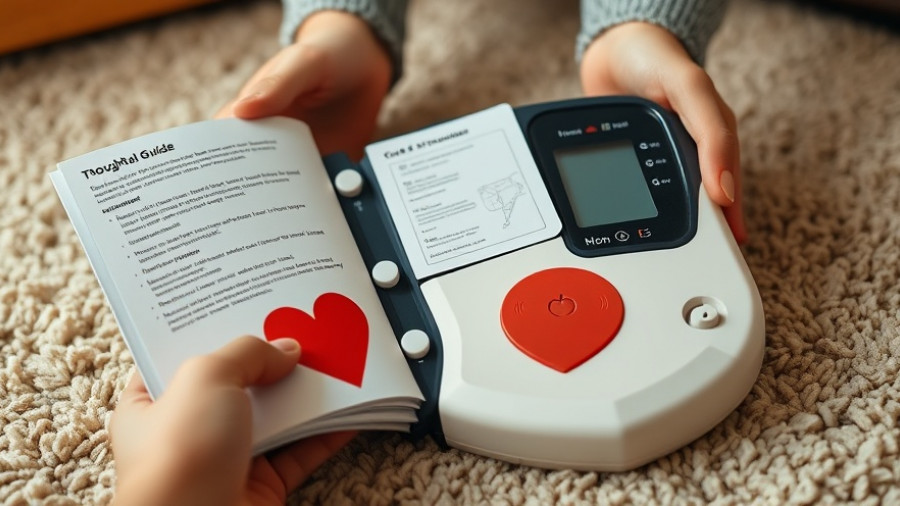
Home Defibrillators: A Beacon of Hope in Cardiac Care
As healthcare professionals, we are consistently on the lookout for innovations that enhance patient care, especially in emergencies. One such advancement, the enterprise of home defibrillators, stands at the forefront of cardiac health strategies aimed at improving survival rates in sudden cardiac arrest situations.
The Efficacy of Home AEDs: Confirming Effectiveness
Data indicates that having an automated external defibrillator (AED) at home can significantly increase survival rates for those experiencing cardiac arrest. Reports from studies reveal that patients with a shockable rhythm had a 26% higher chance of survival when an AED was applied compared to those who did not receive such intervention. This finding supports the idea that having ready access to a device designed to restore heart function can make a critical difference during emergencies, especially when time is of the essence.
Cost-Effectiveness: The Critical Debate
Despite some survival benefits, the cost-effectiveness of home AEDs remains a contentious topic. A recent analysis highlighted that equipping every household with an AED would exceed $4 million per quality-adjusted life-year (QALY), which challenges the justification for such investment across the population. In the face of these figures, we are compelled to consider both the potential life-saving benefits against the backdrop of healthcare budgets constrained by numerous competing priorities.
Current Trends: Balancing Costs and Innovation
As we navigate these discussions, it becomes clear that innovations in technology could change the landscape. The development of cheaper AEDs and AI-driven algorithms for risk assessment may enable targeted deployment of these devices to the homes of those at heightened risk. For instance, individuals with multiple risk factors or a history of heart disease may see greater benefit from home AEDs with fewer financial drawbacks.
The Importance of Quick Response
Statistically, approximately 70% of out-of-hospital cardiac arrests occur in the home, with many individuals facing delays exceeding ten minutes for emergency medical services (EMS) to reach them. This delay can drastically affect survival rates. By increasing the accessibility of AEDs, we can provide immediate assistance, effectively reducing the time-to-defibrillation, a vital factor for survival in cases of cardiac arrest.
Strategies for Integration: A Multidisciplinary Approach
To effectively implement a strategy that complements the use of home AEDs, healthcare entities could extend education on their use alongside structured training programs in CPR. Enhancing both public awareness and training would ensure that every household equipped with an AED is ready for emergencies, thereby maximizing the device's potential benefits.
Emotional Considerations: Humanizing Medical Devices
While the statistics inform our strategies, it is crucial we remember the human aspect behind every number. Each AED represents the promise of life, comfort for families, and the hope of witnessing a loved one thrive again. This emotional component should inform our discussions about the cost versus benefit of implementing widespread home AED usage.
Looking Forward: Future Innovations in Cardiac Care
As we look to the future, it is essential to embrace the developments in technology that could improve AED integration in individual homes. For instance, wearable technologies that can detect cardiac arrest and alert emergency services can transform response times while combining them with home AEDs could significantly enhance survival rates.
Conclusion: Evaluating Value Beyond Costs
In conclusion, the conversation surrounding home AEDs is evolving. While the current cost-effectiveness ratios may not support widespread adoption, embracing emerging technologies alongside education and training initiatives can pivot the narrative towards establishing home AEDs as a valuable healthcare resource rather than merely an expensive option. Exploring these dimensions will help shape public health strategies that prioritize patient safety and well-being.
For healthcare leaders and policymakers, advocating for innovations that prioritize patient survival is vital. Continued dialogue on the cost-benefit ratio of home AEDs is essential; therefore, we invite you to engage further on this topic at your upcoming departmental meetings or educational platforms to explore actionable insights.
 Add Row
Add Row  Add
Add 




Write A Comment